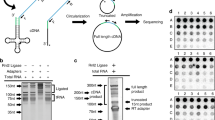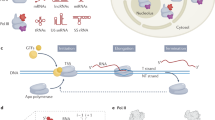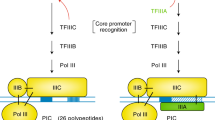Abstract
RNA polymerase III (Pol III) transcription of tRNA genes is essential for generating the tRNA adaptor molecules that link genetic sequence and protein translation. By mapping Pol III occupancy genome-wide in mouse, rat, human, macaque, dog and opossum livers, we found that Pol III binding to individual tRNA genes varies substantially in strength and location. However, when we took into account tRNA redundancies by grouping Pol III occupancy into 46 anticodon isoacceptor families or 21 amino acid–based isotype classes, we discovered strong conservation. Similarly, Pol III occupancy of amino acid isotypes is almost invariant among transcriptionally and evolutionarily diverse tissues in mouse. Thus, synthesis of functional tRNA isotypes has been highly constrained, although the usage of individual tRNA genes has evolved rapidly.
This is a preview of subscription content, access via your institution
Access options
Subscribe to this journal
Receive 12 print issues and online access
$209.00 per year
only $17.42 per issue
Buy this article
- Purchase on Springer Link
- Instant access to full article PDF
Prices may be subject to local taxes which are calculated during checkout





Similar content being viewed by others
Accession codes
References
Chan, E.T. et al. Conservation of core gene expression in vertebrate tissues. J. Biol. 8, 33 (2009).
Guttman, M. et al. Chromatin signature reveals over a thousand highly conserved large non-coding RNAs in mammals. Nature 458, 223–227 (2009).
Marques, A.C. & Ponting, C.P. Catalogues of mammalian long noncoding RNAs: modest conservation and incompleteness. Genome Biol. 10, R124 (2009).
Meader, S., Ponting, C.P. & Lunter, G. Massive turnover of functional sequence in human and other mammalian genomes. Genome Res. 20, 1335–1343 (2010).
Odom, D.T. et al. Tissue-specific transcriptional regulation has diverged significantly between human and mouse. Nat. Genet. 39, 730–732 (2007).
Bourque, G. et al. Evolution of the mammalian transcription factor binding repertoire via transposable elements. Genome Res. 18, 1752–1762 (2008).
Schmidt, D. et al. Five-vertebrate ChIP-seq reveals the evolutionary dynamics of transcription factor binding. Science 328, 1036–1040 (2010).
Kunarso, G. et al. Transposable elements have rewired the core regulatory network of human embryonic stem cells. Nat. Genet. 42, 631–634 (2010).
Barski, A. et al. Pol II and its associated epigenetic marks are present at Pol III–transcribed noncoding RNA genes. Nat. Struct. Mol. Biol. 17, 629–634 (2010).
Canella, D., Praz, V., Reina, J.H., Cousin, P. & Hernandez, N. Defining the RNA polymerase III transcriptome: Genome-wide localization of the RNA polymerase III transcription machinery in human cells. Genome Res. 20, 710–721 (2010).
Moqtaderi, Z. et al. Genomic binding profiles of functionally distinct RNA polymerase III transcription complexes in human cells. Nat. Struct. Mol. Biol. 17, 635–640 (2010).
Oler, A.J. et al. Human RNA polymerase III transcriptomes and relationships to Pol II promoter chromatin and enhancer-binding factors. Nat. Struct. Mol. Biol. 17, 620–628 (2010).
Raha, D. et al. Close association of RNA polymerase II and many transcription factors with Pol III genes. Proc. Natl. Acad. Sci. USA 107, 3639–3644 (2010).
Kindler, S., Wang, H., Richter, D. & Tiedge, H. RNA transport and local control of translation. Annu. Rev. Cell Dev. Biol. 21, 223–245 (2005).
Lowe, T.M. & Eddy, S.R. tRNAscan-SE: a program for improved detection of transfer RNA genes in genomic sequence. Nucleic Acids Res. 25, 955–964 (1997).
Goodenbour, J.M. & Pan, T. Diversity of tRNA genes in eukaryotes. Nucleic Acids Res. 34, 6137–6146 (2006).
Plotkin, J.B. & Kudla, G. Synonymous but not the same: the causes and consequences of codon bias. Nat. Rev. Genet. 12, 32–42 (2011).
White, R.J. Transcription by RNA polymerase III: more complex than we thought. Nat. Rev. Genet. 12, 459–463 (2011).
Dieci, G., Fiorino, G., Castelnuovo, M., Teichmann, M. & Pagano, A. The expanding RNA polymerase III transcriptome. Trends Genet. 23, 614–622 (2007).
Muse, G.W. et al. RNA polymerase is poised for activation across the genome. Nat. Genet. 39, 1507–1511 (2007).
Zeitlinger, J. et al. RNA polymerase stalling at developmental control genes in the Drosophila melanogaster embryo. Nat. Genet. 39, 1512–1516 (2007).
Davuluri, R.V., Suzuki, Y., Sugano, S., Plass, C. & Huang, T.H. The functional consequences of alternative promoter use in mammalian genomes. Trends Genet. 24, 167–177 (2008).
Keren, H., Lev-Maor, G. & Ast, G. Alternative splicing and evolution: diversification, exon definition and function. Nat. Rev. Genet. 11, 345–355 (2010).
Coughlin, D.J., Babak, T., Nihranz, C., Hughes, T.R. & Engelke, D.R. Prediction and verification of mouse tRNA gene families. RNA Biol. 6, 195–202 (2009).
Haeusler, R.A., Pratt-Hyatt, M., Good, P.D., Gipson, T.A. & Engelke, D.R. Clustering of yeast tRNA genes is mediated by specific association of condensin with tRNA gene transcription complexes. Genes Dev. 22, 2204–2214 (2008).
Dittmar, K.A., Goodenbour, J.M. & Pan, T. Tissue-specific differences in human transfer RNA expression. PLoS Genet. 2, e221 (2006).
Kanaya, S., Yamada, Y., Kudo, Y. & Ikemura, T. Studies of codon usage and tRNA genes of 18 unicellular organisms and quantification of Bacillus subtilis tRNAs: gene expression level and species-specific diversity of codon usage based on multivariate analysis. Gene 238, 143–155 (1999).
Plotkin, J.B., Robins, H. & Levine, A.J. Tissue-specific codon usage and the expression of human genes. Proc. Natl. Acad. Sci. USA 101, 12588–12591 (2004).
Sémont, A. et al. Mesenchymal stem cells increase self-renewal of small intestinal epithelium and accelerate structural recovery after radiation injury. Adv. Exp. Med. Biol. 585, 19–30 (2006).
Blouin, A., Bolender, R.P. & Weibel, E.R. Distribution of organelles and membranes between hepatocytes and nonhepatocytes in the rat liver parenchyma. A stereological study. J. Cell Biol. 72, 441–455 (1977).
Romer, A.S. & Parsons, T.S . The Vertebrate Body (Saunders College Pub., Philadelphia, 1986).
Gibbs, R.A. et al. Genome sequence of the Brown Norway rat yields insights into mammalian evolution. Nature 428, 493–521 (2004).
Lindblad-Toh, K. et al. Genome sequence, comparative analysis and haplotype structure of the domestic dog. Nature 438, 803–819 (2005).
Rogers, H.H., Bergman, C.M. & Griffiths-Jones, S. The evolution of tRNA genes in Drosophila. Genome Biol. Evol. 2, 467–477 (2010).
Willis, I.M. RNA polymerase III. Genes, factors and transcriptional specificity. Eur. J. Biochem. 212, 1–11 (1993).
Paten, B., Herrero, J., Beal, K., Fitzgerald, S. & Birney, E. Enredo and Pecan: genome-wide mammalian consistency-based multiple alignment with paralogs. Genome Res. 18, 1814–1828 (2008).
Paten, B., Herrero, J., Beal, K. & Birney, E. Sequence progressive alignment, a framework for practical large-scale probabilistic consistency alignment. Bioinformatics 25, 295–301 (2009).
Chiaromonte, F., Yap, V.B. & Miller, W. Scoring pairwise genomic sequence alignments. Pac. Symp. Biocomput. 7, 115–126 (2002).
Kent, W.J., Baertsch, R., Hinrichs, A., Miller, W. & Haussler, D. Evolution's cauldron: duplication, deletion, and rearrangement in the mouse and human genomes. Proc. Natl. Acad. Sci. USA 100, 11484–11489 (2003).
Man, O. & Pilpel, Y. Differential translation efficiency of orthologous genes is involved in phenotypic divergence of yeast species. Nat. Genet. 39, 415–421 (2007).
Duret, L. & Galtier, N. Biased gene conversion and the evolution of mammalian genomic landscapes. Annu. Rev. Genomics Hum. Genet. 10, 285–311 (2009).
Thompson, M., Haeusler, R.A., Good, P.D. & Engelke, D.R. Nucleolar clustering of dispersed tRNA genes. Science 302, 1399–1401 (2003).
Gerstein, M.B. et al. Integrative analysis of the Caenorhabditis elegans Genome by the modENCODE project. Science 330, 1775–1787 (2010).
Kasowski, M. et al. Variation in transcription factor binding among humans. Science 328, 232–235 (2010).
Roy, S. et al. Identification of functional elements and regulatory circuits by Drosophila modENCODE. Science 330, 1787–1797 (2010).
Gandhi, S.J., Zenklusen, D., Lionnet, T. & Singer, R.H. Transcription of functionally related constitutive genes is not coordinated. Nat. Struct. Mol. Biol. 18, 27–34 (2011).
Schmidt, D. et al. ChIP-seq: using high-throughput sequencing to discover protein-DNA interactions. Methods 48, 240–248 (2009).
Fairley, J.A., Scott, P.H. & White, R.J. TFIIIB is phosphorylated, disrupted and selectively released from tRNA promoters during mitosis in vivo. EMBO J. 22, 5841–5850 (2003).
Li, H. & Durbin, R. Fast and accurate short read alignment with Burrows-Wheeler transform. Bioinformatics 25, 1754–1760 (2009).
Mortazavi, A., Williams, B.A., McCue, K., Schaeffer, L. & Wold, B. Mapping and quantifying mammalian transcriptomes by RNA-Seq. Nat. Methods 5, 621–628 (2008).
Lemon, J. Plotrix: a package in the red light district of R. R-News, 6, 8–13 (2006).
Schwartz, S. et al. Human-mouse alignments with BLASTZ. Genome Res. 13, 103–107 (2003).
Waterston, R.H. et al. Initial sequencing and comparative analysis of the mouse genome. Nature 420, 520–562 (2002).
Langmead, B., Trapnell, C., Pop, M. & Salzberg, S.L. Ultrafast and memory-efficient alignment of short DNA sequences to the human genome. Genome Biol. 10, R25 (2009).
Turro, E. et al. Haplotype and isoform specific expression estimation using multi-mapping RNA-seq reads. Genome Biol. 12, R13 (2011).
Robinson, M.D. & Oshlack, A. A scaling normalization method for differential expression analysis of RNA-seq data. Genome Biol. 11, R25 (2010).
Acknowledgements
We thank J. Hadfield, N. Matthews, S. Aldridge, S. Sayalero, C. Fielding, B. Davis, K. Howe, R. Stark, T. Davidge, S. Ballantyne and M. Nixon. This work was supported by the European Research Council Starting Grant; the European Molecular Biology Organization Young Investigator Award; Hutchinson Whampoa (D.T.O.); Swiss National Science Foundation (C.K.); University of Cambridge (C.K., M.D.W. and D.T.O.); Cancer Research UK (C.K., G.D.B., S.W., M.D.W., R.J.W. and D.T.O.) and European Molecular Biology Laboratory (A.G.).
Author information
Authors and Affiliations
Contributions
C.K., G.D.B. and D.T.O. conceived experiments. C.K., S.W. and M.D.W. carried out experiments. G.D.B., C.K. and A.G. analyzed the data. C.K., G.D.B., A.B., R.J.W. and D.T.O. wrote the paper.
Corresponding author
Ethics declarations
Competing interests
The authors declare no competing financial interests.
Supplementary information
Supplementary Text and Figures
Supplementary Figures 1–14 and Supplementary Tables 1 and 8–11 (PDF 1857 kb)
Supplementary Table 2
Genomic location of pol III-bound mouse tRNA genes (XLS 241 kb)
Supplementary Table 3
Genomic location of pol III-bound rat tRNA genes (XLS 99 kb)
Supplementary Table 4
Genomic location of pol III-bound human tRNA genes (XLS 88 kb)
Supplementary Table 5
Genomic location of pol III-bound macaque tRNA genes (XLS 85 kb)
Supplementary Table 6
Genomic location of pol III-bound dog tRNA genes (XLS 65 kb)
Supplementary Table 7
Genomic location of pol III-bound opossum tRNA genes (XLS 81 kb)
Rights and permissions
About this article
Cite this article
Kutter, C., Brown, G., Gonçalves, Â. et al. Pol III binding in six mammals shows conservation among amino acid isotypes despite divergence among tRNA genes. Nat Genet 43, 948–955 (2011). https://doi.org/10.1038/ng.906
Received:
Accepted:
Published:
Issue Date:
DOI: https://doi.org/10.1038/ng.906
This article is cited by
-
Selective gene expression maintains human tRNA anticodon pools during differentiation
Nature Cell Biology (2024)
-
The expanding world of tRNA modifications and their disease relevance
Nature Reviews Molecular Cell Biology (2021)
-
The effects of codon bias and optimality on mRNA and protein regulation
Cellular and Molecular Life Sciences (2021)
-
Modifications and functional genomics of human transfer RNA
Cell Research (2018)
-
Topological organization and dynamic regulation of human tRNA genes during macrophage differentiation
Genome Biology (2017)



